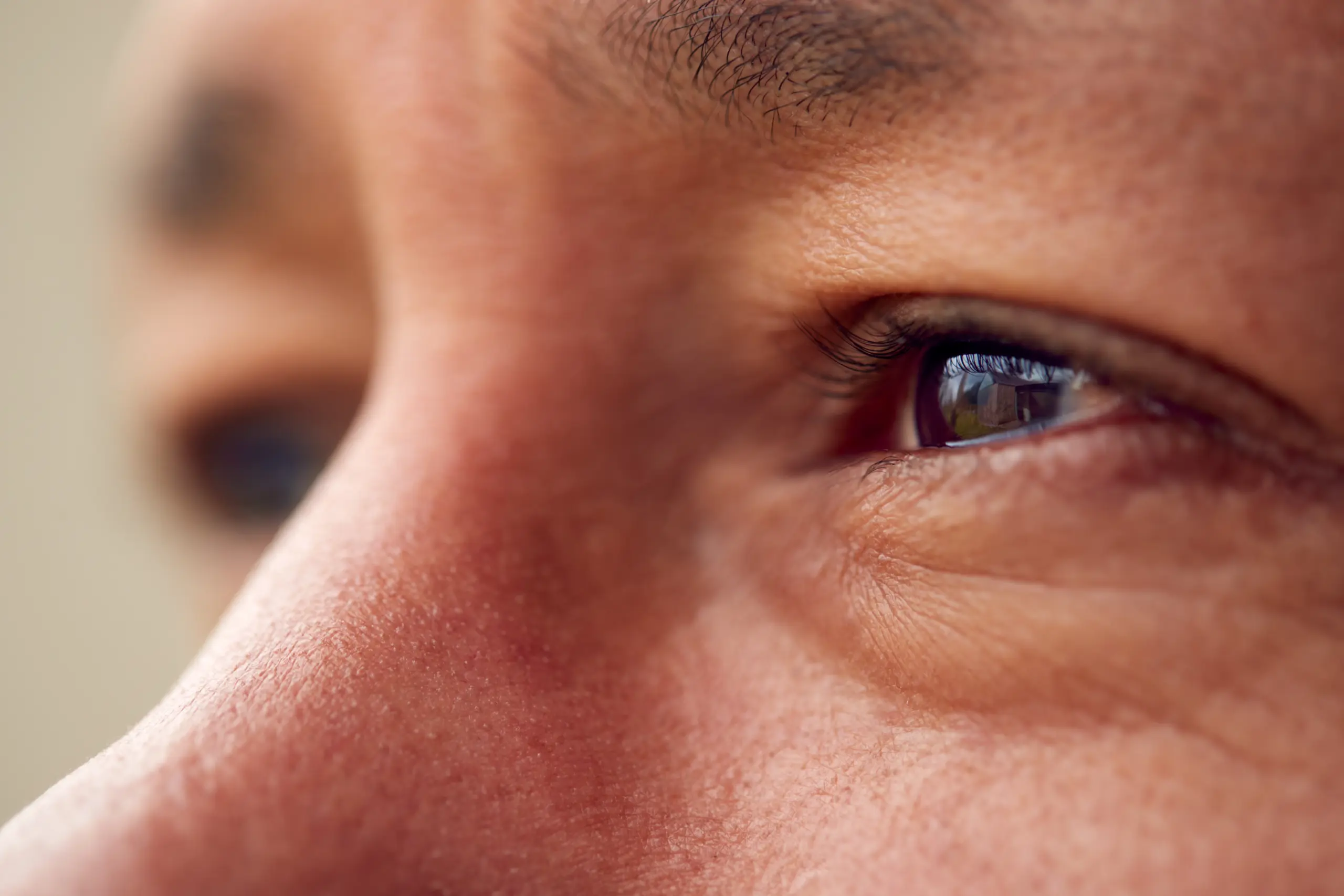Noticing that one or both of your eyelids have started to sag? This common condition, known as a droopy eyelid or medically as ptosis of eyelid, is more than just a cosmetic concern. It can affect your vision and how you feel about your appearance.
Ptosis treatment restores the natural height and symmetry of the eyelids by addressing the weakened muscle responsible for lifting them. While mild cases may improve temporarily with prescription eye drops, lasting correction usually requires ptosis repair surgery.
What Is Ptosis of the Eyelid and What Types Are There?
In simple terms, ptosis of the eyelid is a drooping of the upper eyelid. It can happen in one or both eyes, and the droop can be barely noticeable or severe enough to cover your pupil.
There are two main types:
- Congenital Ptosis: This is present at birth and occurs when the levator muscle, responsible for lifting the eyelid, doesn’t develop properly.
- Acquired Ptosis: This develops later in life and is much more common. It can be caused by aging, an injury, or as a side effect of other medical conditions. For many, the solution is a specialised ptosis procedure to correct the underlying muscle issue.
Ptosis means the lid margin sits too low. If your lids look heavy because of excess skin rather than a weak muscle, that typically can be treated with blepharoplasty.
See how both compare in our blepharoplasty vs ptosis repair comparison guide.
What Causes Ptosis?
Understanding ptosis causes is key to determining the right treatment. The most common cause is a natural part of getting older. As we age, the tendon that connects the levator muscle to the eyelid can stretch or thin leading to a gradual droop. However, other ptosis causes can include:
- Age-related weakening of the eyelid muscle
- Medical conditions, such as Myasthenia Gravis, a neuromuscular disorder, or Horner’s syndrome.
- Long-term contact lens wear, which can stretch the eyelid muscles over time.
- An eye injury or previous eye surgery.
In rare cases, a brain tumour or neurological issue can cause ptosis, which is why a proper diagnosis is so important.
Symptoms of a Droopy Eyelid
How do you know if you have a droopy eyelid? The most obvious sign is the sagging appearance itself. But other symptoms often include:
- A heavy feeling in the eyelids.
- Difficulty keeping your eyes open, leading to eyebrow strain from constantly raising them to see.
- Reduced vision, especially in the upper part of your field of view.
- Tired-looking or asymmetrical eyes.
What are the risks related to droopy eyelids
Leaving a significant droopy eyelid untreated can lead to more than just a tired appearance. The biggest risk is amblyopia, or “lazy eye,” especially in children, where the brain starts to ignore the input from the affected eye.
For adults, the constant effort to raise the eyelids can lead to tension headaches and eyebrow strain. Most importantly, if the droop obscures your pupil, it can seriously impact your peripheral vision and make daily activities like driving dangerous.
How Is Ptosis Diagnosed?
If you suspect you have ptosis of the eyelid, the first step is to see a GP or a specialist ophthalmologist (eye surgeon). They will conduct a thorough examination, which typically includes:
- A detailed history of your symptoms.
- Measuring the height of your eyelid opening.
- Testing your eyelid muscle strength and function.
- A full vision test to check if your sight is affected.
Your exam distinguishes true ptosis from dermatochalasis, if it’s skin redundancy, a saggy eyelid surgery will be a more suited option.
Ptosis Treatment
The right ptosis of the eyelid treatment depends entirely on the underlying cause, its severity, and whether it’s affecting your vision. The goal is always to restore a natural, symmetrical, and alert appearance while safeguarding your eyesight.
Non Surgical Options
So, can a droopy eyelid be fixed? Absolutely. For very mild cases, some people wonder how to stop droopy eyelids from getting worse. While you can’t reverse natural aging, managing contributing factors like choosing glasses over contacts occasionally can help.
Other non surgical options, like prescription eye drops, can lift the eyelid temporarily. However, for a definitive correction, surgery is the only proven and effective method.
The Surgical Option Approach
The most common and effective solution is a ptosis procedure, a precise surgery called ptosis repair that tightens or reattaches the levator muscle to restore your eyelid’s natural position. Let’s walk you through what it actually involves.
The surgery is typically performed as a day case under local anaesthetic, meaning you’ll be awake but feel no pain. The process generally follows these steps:
Marking and Anaesthetic: First, your surgeon will carefully mark the natural crease of your eyelid where the incision will be made. A local anaesthetic is then injected to numb the entire area.
The Incision: The surgeon makes a precise cut along the marked line. This strategic placement ensures the scar is hidden when your eyes are open.
Muscle Adjustment: The surgeon then locates the levator muscle. Depending on its strength, they will either shorten it by removing a small section and reattaching it, or tighten it with sutures.
Closing: The incision is closed with very fine sutures, which may be dissolvable or need removal after about a week.
How Can You Prevent Ptosis of the eyelid
The short answer is that you can’t prevent every case (ageing and genetics play a role), but you can lower the risk and slow things down.
Simple habits that help:
- Go easy on eye rubbing. Treat allergies/dry eye so you’re not constantly tugging at lids.
- Contact lens care. Limit long hours, use the right fit, and handle lenses gently, years of pulling can stretch the lid.
- Choose injectors wisely. Poorly placed injections can cause temporary lid droop
- Sun + skin care. Daily SPF, sunglasses, and gentle skincare keep lid skin healthier over time.
- Quit smoking. Smoking speeds tissue ageing and healing problems.
- Manage health issues. If you have neuromuscular or thyroid conditions, staying well-controlled helps protect eyelid function.
- Sleep and screens. Good sleep, blink breaks, and lubricating drops reduce strain and dryness.
When Should You See a Doctor for a Droopy Eyelid?
You should schedule an appointment with your doctor if your droopy eyelid:
- Develops suddenly over a few days or hours.
- Is accompanied by double vision, eye pain, or a severe headache.
- Follows an injury to your eye or head.
- Affects your ability to see clearly.
A sudden onset can sometimes indicate a more serious neurological problem, so it’s always best to get it checked promptly.
Frequently Asked Questions (FAQs)
For a permanent solution, surgical correction (called ptosis repair) is the only way to get rid of droopy eyelids. Non-surgical treatments like injections can be used in very specific cases to create a “lifted” appearance, but they do not address the underlying muscle issue.
Non-surgical options are limited. Mild ptosis may temporarily improve with prescription eye drops that stimulate the muscles lifting the eyelid, but the effect only lasts a few hours. For most cases, especially when the muscle is weak or stretched, surgery is the only reliable, long-term solution.
If left untreated, ptosis can gradually worsen. It may obstruct vision, cause eye strain or headaches, and lead to asymmetry between the eyes. In children, untreated ptosis can even interfere with visual development and cause amblyopia (lazy eye).
Ptosis caused by fatigue, temporary nerve irritation, or certain medications can sometimes improve once the underlying issue resolves. However, most cases, especially those due to ageing or muscle weakness do not go away on their own and require surgical correction for lasting improvement.
The most common cause is age-related weakening or stretching of the levator muscle tendon, known as involutional ptosis. Other causes include congenital muscle weakness, nerve damage, trauma, or certain medical conditions that affect muscle control.
Ready to Fix Your Droopy Eyelids?
Living with a droopy eyelid can be frustrating. However, with modern and precise surgical techniques, you can achieve a more alert, symmetrical, and youthful appearance while protecting your precious eyesight.
Book a free consultation with one of our expert surgeons today. We’ll provide you with a clear diagnosis, discuss your personalised treatment options, and help you see the world in a whole new light.






